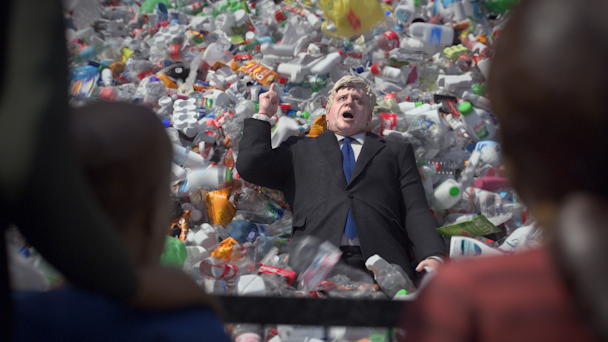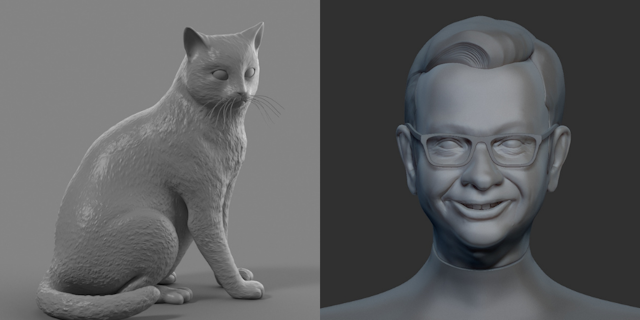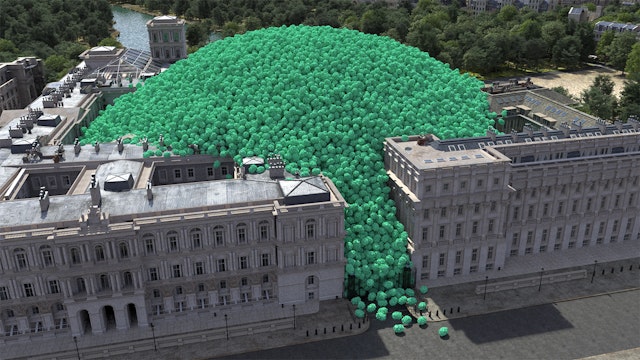How Greenpeace trashed UK gov’s plastic export scam with ‘Wasteminster’

The team did a lot of research in order to accurately depict 1.8m tonnes of plastic
Weird, informative and visually effective, Greenpeace’s ‘Wasteminster’ castigated the British government over its handling of plastic, pouring 1.8m kilos of it over the prime minister to do so. Here, creatives at Park Village and Studio Birthplace explain how they did it.
The United Kingdom dumps 1.8m kilos of plastic on other countries every single day. That’s 688,000 tonnes of plastic a year that doesn’t get recycled but sent overseas to the detriment of local communities and their wildlife.
Recycling in the UK is built on a myth. Hoping to bust it, the UK government is high up on Greenpeace’s hit list. It wants to ban all exports of plastic, as the European Union did in December last year, which it details in a report titled: ‘Trashed: How the UK is still dumping plastic waste on the rest of the world’. It just needed help visualize the extent of the plastic waste the UK dumps on other countries, which is where humanitarian and ecological specialists Studio Birthplace came in.
“There wasn’t actually a brief. Greenpeace already had a plastics campaign that they were keen to launch,” recalls Adam Booth, managing partner and executive producer at Park Village. “It was looking for a leading campaign film to launch the Trashed report.”
Noting the serendipitous timing, Booth says Greenpeace wanted something that would visualize the extent of the report, without chopping something together using stock footage, and Studio Birthplace had made a test film called ‘Humanity’s Impact’ that fitted the bill. The test animation is a similar simulation to Wasteminster, but in a different environment – instead of dropping tonnes of plastic on Whitehall, it focused on the number of plastic bottles globally produced in real-time, with an American culture vibe.
“The starter for that pilot episode had a history with our previous projects where we were focusing on plastic pollution in the ocean and on deforestation,” details Sil van der Woerd, co-founder, creative director and producer at Studio Birthplace. “We were reading these big reports by Greenpeace and WWF and thinking, what do these massive numbers actually look like? Can we create a personal relation to those numbers?”
“And then we took that Humanity’s Impact to Greenpeace. They saw that test film and what the guys could create, and they were inspired to use that as the lead for the campaign, but to drop the plastic on Downing Street,” Booth says.
Jorik Dozy, co-founder and creative director, Studio Birthplace, recalls how they started quite regularly with a script with which they tried to find a story. “And then, quite fast, we started to transition that into pre-visualization in 3D, into very rough shapes and forms. You start blocking out the script into a 3D world, trying to understand how the pace of the film would go,” he explains.
“And then after that, we started to create our mannequins of Boris Johnson and Michael Gove. We kicked that off quite early. And then from there on, it was a lot of set-building, and a couple months of simulation of the plastic, really trying to finesse the performance of the plastic and Boris riding the wave.”
In the animation, UK prime minister Boris Johnson appears as a floundering caricature of himself, pontificating on the plastic issue in front of the world’s media as a curtain-twitching Michael Gove and Larry the cat linger closer by. While the message of the campaign is undoubtedly a sober one, van der Woerd explains: “At Studio Birthplace, we’re always looking to talk differently about important subjects. We’re often confronted with them through the news, or through articles, and it’s often horrifying or it’s very factual,” which is why Wasteminster uses caricature and comedy to engage people.
“It’s very important to find that line to bring an important message to your audience in the right manner.”

While figuring out what Johnson should be saying to the press, Dozy explains: “We didn’t want to put words into Boris’s mouth. All statements in the film were made by Boris and the government.”
So they went through hours of interviews and speeches by Boris and the government where plastic pollution and the environment were discussed and quotes were extracted.
Van der Woerd details how the team did a lot of research in order to accurately depict 1.8m tonnes of plastic. “We firstly had to understand, what plastic goes into recycling? In the end, we broke it down to 150 different plastic items, like bottles, bottle caps, food containers and plastic bags,” he recalls.

Studio Birthplace then explored the empty weights of the items to understand how much they weigh. “We knew from the data from Greenpeace that 1.8m kilograms of plastic is exported each day. So we figured that resulted in 67 million pieces of plastic, which we then had to visualize,” he explains.
You can watch ‘Wasteminster’ in full below.


